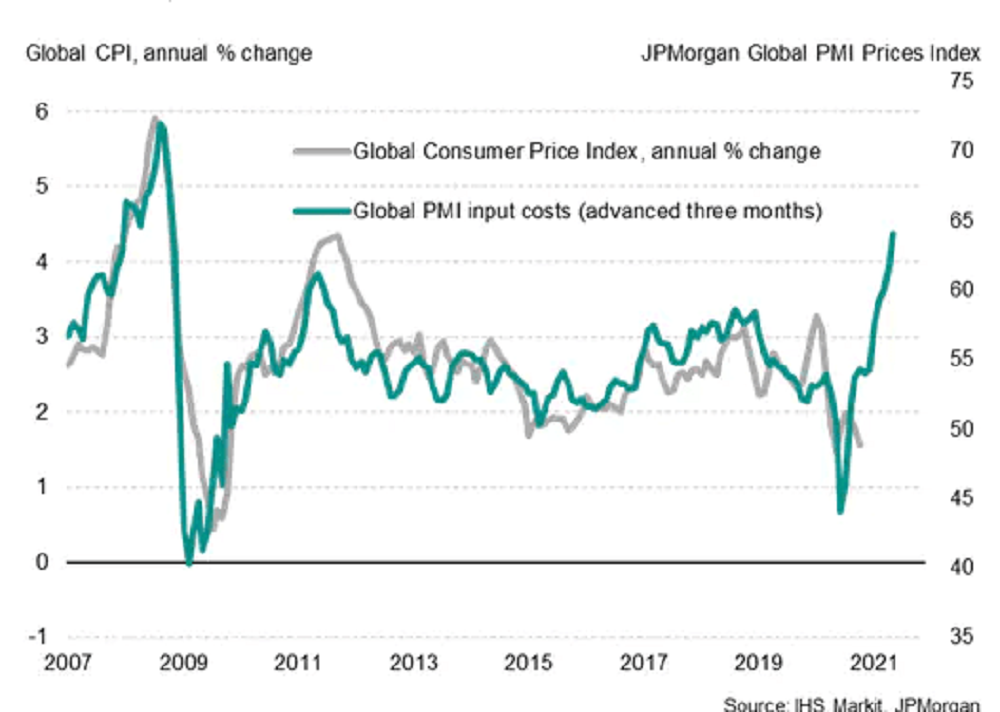How does global inflation impact the FX market?
Until not too long ago, all kinds of inflation seemed to be considered as bad. But then came the period of lowflation and, for some, almost permanent deflation. The question now is whether a rise in inflation is seen as good. How will it impact the FX market.

The scenario the market seems to be working off is one in which global supply strains ease, economic growth recovers, and the surge in inflation that we’ve seen retreats again. Judging by global inflation expectations it seems that the market is seeing this as “good” inflation because the rise will enable central banks to achieve ongoing inflation performance that is closer to their targets (which are usually around 2%) than they were accomplishing before the pandemic struck; once this current inflation hump is over. All this bears well for a resumption of the reflation trade with perhaps a particular focus on those sectors of the market that might have lagged behind so far, like emerging markets. The problem, of course, is that the market could be expecting all of this more out of hope than any real conviction that it will come to pass.
For there is an alternative, “bad” inflation story. This is one in which either supply chain pressures don’t ease anytime soon, or else they do but rising inflation has a momentum of its own as price expectations gallop ahead and wages rise in tandem. In this scenario, inflation stays well above the sorts of levels that seem consistent with achieving central bank inflation targets. The banks would then have a choice; either remain patient or recognize the inflation threat and move monetary tightening along faster than markets expect and they themselves might have hinted. The danger in the latter path is that asset prices collapse as investors dance to the tune of the stagflation trade, not the reflation trade. And this, in turn, could really hurt the more vulnerable parts of the market, like EM.
Mr. Steve Barrow, Head of Standard Bank G10 Strategy suggested that financial markets would seem to be in this sort of position; hoping for the best and ignoring the worst until, that is, the worst strikes. But at this juncture with inflation not just rising but also proving a relatively new problem for both central banks and private investors, the juxtaposition between the ‘good’ outcome and the ‘bad’ one seems quite stark. The ‘bad’ outcomes that investors have had to deal with in the recent past have not been to do with inflation or central banks scrambling to catch up. Instead, they have been about adverse shocks like the pandemic, the eurozone debt crisis of 2010-12, and the global financial crisis of 2008. These shocks materialized quite rapidly and the reaction in the market was swift as a result. Right now, we’re facing more of a slow train wreck as inflation rises but central banks try to stay calm.
For the FX market, the two scenarios clearly have opposite implications for the dollar and, indeed, most other currencies. The ‘good’ inflation scenario is consistent with a weaker dollar over time as global recovery expands, inflation retreats and the Fed can avoid being forced into any super-quick monetary tightening. The ‘bad’ inflation scenario is one of asset price carnage and flows into safe-haven currencies, of which the dollar is one. Whether this juxtaposition is part of the reason why the dollar has been very stable against other developed currencies, as investors juggle these two scenarios, is anyone’s guess. “We suspect that it is more than this. But if it is a key factor, could the dollar’s recent rise signal that the ‘bad’ inflation story is just starting to gain the upper hand; something we might also be seen in the bond market as well? Only time will tell but, while the ‘good’ inflation ending might still be the favorite we think investors will prepare themselves some more from the, not very pleasant, alternative”, Mr. Steve Barrow said.








